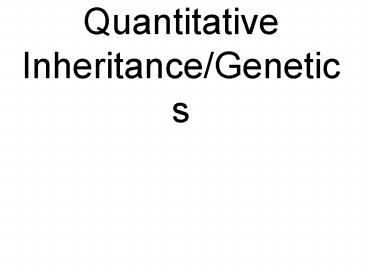Quantitative InheritanceGenetics PowerPoint PPT Presentation
1 / 23
Title: Quantitative InheritanceGenetics
1
Quantitative Inheritance/Genetics
2
Statistical Methods Evaluate A Frequency
Distribution
- Statistical tools are used to analyze a normal
distribution in a number of ways - One measure, the mean computed using the
following formula
- where
- X is the sum of all values in the group
N is the number of individuals in the group
3
(No Transcript)
4
- In genetics,interest exists in the amount of
phenotypic variation that exists in a group - A common way to evaluate variation within a
population is a statistic called variance
where, VX is the variance
N is the number of observations
5
(No Transcript)
6
- Variances are very important in the analysis of
quantitative traits because they are additive
under certain conditions - The variances of genetic and environmental
factors that contribute to a quantitative trait
can be added to predict the total variance for
that trait - To gain an intuitive grasp of variation, we can
take the square root of the variance - The statistic is standard deviation
7
Polygenic Inheritance
a situation in which _____ gene loci or multiple
gene loci contribute to a single phenotypic
trait.
8
Polygenic Inheritance
To date, Traits discussed have clearly
identifiable phenotypes with limited
variability. eg., red / white hair color in
cattle, belting in swine.
9
Traits discussed to date have been qualitative,
- phenotypes - easy to identify
- no need to measure
- the trait
- controlled by a few
- (1-2) loci
10
Now quantitative traits,
the phenotype exhibits very small phenotypic
variations not readily distinguishable eg.,
phenotype - steer gaining 3.1 /day vs 3.2 is
real but difficult to identify
11
First Demonstration of a Polygenic Trait-
Nilsson-Ehle Experiment Red and White wheat
pigment in wheat hulls
12
First demonstration of continuous variation
related to polygenic inheritance, 1909
- Swedish geneticist, Herman Nilsson-Ehle - the
inheritance of red pigment in the hull of wheat
Triticum aestivum
13
- - P True-breeding red X true- breeding
white - F1 Intermediate red
- F2 Great variation in redness
- White, light red, intermediate red, medium red,
dark red - Colors fell into a 14641 ratio
- Two different genes that control hull color
- Each gene exists in two alleles red or white
- Two loci contribute additively to the color of
hull
14
Phenotypic variation in quantitative traits is
continuous
- Quantitative traits controlled by many gene
loci on numerous chromosomes. - - Gene loci with small positive contributions
(non-dominant) to the phenotype are additive
genes and additive gene actions. - - Loci that contribute to the phenotype but
actions are dominance and epistasis, non-additive
genes
15
- Quantitative genes segregate separately from
each other and have specific effects.
- Dominance, epistasis, and linkage involving
both autosomes and sex-linked genes are
associated with polygenic /quantitative traits.
A hypothetical example of polygenic inheritance,
White Spotting in Cows.
16
Inheritance of Hypothetical Spotting in Cattle
10 White 50 White 90 White
Ref J. Hered. 1999 (90)629-34.
17
Inheritance of Hypothetical Spotting in Cattle
- Number of Possible
Degree Nos. in - Additive Genes Genotypes (9) of
Spotting Phenotype - 0 aaee
10 white, 1 - 9 0 black
- 1 Aaee, aaEe
30 white, 4 -
70 black - 2 AAee, aaEE,
50 white, 6 - AaEe
50 black - 3 AAEe, AaEE
70 white, 4 -
30 black - 4 AAEE
90 white, 1 -
10 black
16
- Dihybrid cross - 2 pairs of alleles A,a and
E,e - Let A, E more spotting a,e neutral, no
spotting - A and E contrib. same amt. of increasing wht.
20 animals surface.
Assume
18
Theoretical Expectations in F2 Populations with
Trait Controlled by Polygenic Inheritance
- Chance of
- Number of Pairs Size of F2 Necessary
No. of Phenotype Obtain. - of Alleles for All Combinations
Classes Either Extreme - 1 4
3 1/4 - 2 16
5
1/16 - 3 64
7
1/64 - 4 256
9
1/256 - 5 1024
11 1/1024 - 6 4096
13 1/4096 - n 4 n
2 n1 1/4 n
2 Pairs of alleles in F2 Dihybrid cross
various phenotypic ratios 9331 , 363121
, 934, now 14641 (prev. slide).
19
Polygenic Inheritance of Mature Size in Chickens
- Number of Additive Number of
- Genes
Phenotype Animals
0 750
g 1 - 1 825 g 8
- 2 900 g 28
- 3 975 g 56
- 4 1050 g 70
- 5 1125 g 56
- 6 1200 g 28
- 7 1275 g 8
- 8 1350 g 1
256
- Mature size controlled by 4 pairs of
hypothetical genes - Genes A,B,C,D contr. 75 g ea. genes a,b,c,d
no contrib. aabbccdd 750 g bird
20
Polygenic Inheritance of Mature Size in Chickens..
- Number of Additive Number of
- Genes
Phenotype Animals
0
750 g 1 - 1 825 g 8
- 2 900 g 28
- 3 975 g 56
- 4 1050 g 70
- 5 1125 g 56
- 6 1200 g 28
- 7 1275 g 8
- 8 1350 g 1
256
- AaBbCcDd x AaBbCcDd 256 combinations, 9
phenotypic. classes - What are the genotypes of the 70 1050g
birds?
21
Histogram of Chicken Weights
70
Apply a Normal
Distribution
60
Curve
50
40
Number
30
20
10
0
750
825
900
975
1050
1125
1200
1275
1350
Weight in Grams
What happens to the phenotypic distinctions
between phenotypes if the no. of phenotypes
increases? Genotypes?
22
Other Names (aka) for Quantitative Traits
- Polygenic
- Continuous
- Metric
23
Examples of polygenic / quantitative traits (and
their unit of measure)
in Cattle ? Dogs ? Horses
? Chickens ? Big Horn Sheep ? Trout /
Salmon ? Wolves ?

